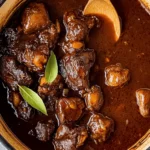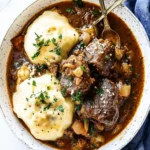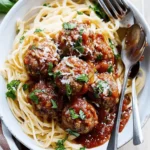Tamales are a traditional and symbolic Mexican dish made from masa (corn dough) filled with meats, vegetables, or sweet mixtures, wrapped in corn husks, and steamed to perfection. They hold deep cultural significance and are commonly prepared for festive occasions like Mexican Independence Day. The process of making tamales is often a communal event, passed down through generations, making it as much about family and celebration as it is about flavor.
FULL RECIPE
Ingredients
1.For the Masa:
- 4 cups masa harina
- 2 ½ cups warm chicken broth (or vegetable broth)
- 1 ½ tsp baking powder
- 1 tsp salt
- 1 cup lard or vegetable shortening
2.For the Filling (Pork in Red Sauce):
- 2 lbs pork shoulder, cooked and shredded
- 3 dried guajillo chiles, stemmed and seeded
- 2 dried ancho chiles, stemmed and seeded
- 3 garlic cloves
- 1 tsp ground cumin
- ½ tsp dried oregano
- 1 cup pork broth (from boiling pork) or water
- Salt to taste
3.Other:
- 30 dried corn husks, soaked in warm water for 30 minutes
- Steamer or large pot with steamer insert
Directions
- Prepare the Pork Filling:
- Boil pork shoulder in salted water until very tender (about 1.5–2 hours). Shred the meat and reserve 1 cup of the broth.
- Toast the dried chiles lightly in a skillet, then soak them in hot water for 15 minutes until soft.
- Blend soaked chiles with garlic, cumin, oregano, and reserved pork broth until smooth. Strain the sauce if desired.
- Simmer shredded pork in the red chile sauce for 10 minutes. Season with salt and set aside.
- 2. Make the Masa:
- In a large bowl, beat the lard or shortening until fluffy.
- In a separate bowl, mix masa harina, baking powder, and salt. Gradually add the warm broth until a soft dough forms.
- Add the dough to the whipped lard in batches, beating until light and spreadable. The dough is ready when a small ball floats in water.
- 3. Assemble the Tamales:
- Pat dry soaked corn husks. Spread about 2 tablespoons of masa dough onto the wide end of a husk, leaving space at the edges.
- Add about 1 tablespoon of pork filling in the center.
- Fold the sides of the husk over the filling, then fold the bottom up to seal.
- Repeat until all masa and filling are used.
- 4. Steam the Tamales:
- Arrange tamales vertically in a steamer with the open ends up. Cover with extra husks or a damp towel.
- Steam over boiling water for 1 to 1.5 hours, checking occasionally to add more water to the pot.
- Tamales are done when the masa separates easily from the husk.
- 5. Serve and Enjoy:
- Let tamales rest for 10 minutes before serving. Enjoy with salsa, crema, or a side of beans.
Nutrition Facts
- Calories: 250 kcal
- Protein: 12g
- Total Fat: 13g
- Saturated Fat: 4g
- Carbohydrates: 22g
- Fiber: 3g
- Sugars: 1g
- Sodium: 420mg
- Cholesterol: 25mg
- Iron: 1.8mg
- Calcium: 20mg
- Vitamin A: 150IU
Cultural Importance of Tamales in Mexican Celebrations
Tamales are more than just a dish in Mexican culture—they are a symbol of tradition, family, and celebration. Often prepared during holidays like Mexican Independence Day, Christmas, and Día de los Muertos, tamales represent a communal cooking experience where multiple generations gather to share stories and recipes. Their history dates back to pre-Columbian times, where tamales served as portable food for warriors and travelers. Today, they carry the legacy of indigenous and Spanish influences, making them a culinary emblem of Mexico’s rich and diverse heritage.
The Role of Masa in Tamales
Masa, made from masa harina and broth or water, is the heart of a tamale. It creates the soft, fluffy texture that wraps around the savory or sweet fillings. The quality of the masa greatly influences the final product. When whipped correctly, often with lard or vegetable shortening, the dough becomes light and airy, yet sturdy enough to hold its shape after steaming. Properly prepared masa is key to achieving that satisfying balance of softness and structure that tamales are known for.
Why Corn Husks Are Essential
Corn husks are traditional wrappers used to encase tamales during the steaming process. These dried leaves, soaked beforehand to make them pliable, serve both practical and cultural purposes. They keep the tamales intact while allowing steam to circulate, infusing the dough with moisture and a subtle corn aroma. Husk-wrapped tamales are also visually distinctive and help with portion control. Additionally, the ritual of wrapping and folding each tamale contributes to the communal and celebratory nature of the dish.
Flavor and Texture Highlights
Tamales offer a unique combination of flavors and textures. The masa is mildly flavored, slightly sweet, and tender when properly steamed. It contrasts beautifully with the bold fillings, which can range from spicy pork in red chile sauce to vegetables, cheese, or even sweet ingredients like raisins and cinnamon. The corn husk wrapping doesn’t get eaten, but it imparts a delicate aroma during steaming that adds a layer of depth to the overall sensory experience. The result is a comforting, hearty dish with layers of flavor in every bite.
Health Benefits and Nutritional Perspective
While tamales are often considered indulgent, they can be part of a balanced diet when made with mindful ingredients. Corn masa is a gluten-free source of complex carbohydrates and provides energy-boosting nutrients like B vitamins and fiber. Fillings such as lean meats, beans, or vegetables can add protein, iron, and antioxidants. Choosing vegetable shortening instead of lard can reduce saturated fat, and steaming (as opposed to frying) preserves nutrients while keeping the dish lower in calories. Portion control is also key, as tamales are typically dense and satisfying.
Creative Filling Variations
Tamales can be customized in countless ways, allowing for creative culinary experimentation. Popular savory fillings include shredded chicken in green salsa, beef with mole, or beans and cheese for a vegetarian option. Sweet tamales, made with sweetened masa and ingredients like pineapple, coconut, or chocolate, offer a delicious dessert twist. Modern adaptations might incorporate non-traditional elements such as spinach and feta, chipotle turkey, or even vegan alternatives using jackfruit or tofu. This versatility makes tamales suitable for nearly every palate and dietary preference.
Tips for Perfect Tamale Assembly
Making tamales can be labor-intensive, but a few key tips can streamline the process and improve the results. Ensuring the masa is well-whipped is essential—it should be light, fluffy, and spreadable. Soaking corn husks long enough to make them flexible helps prevent tearing. When assembling, don’t overfill, as this can cause tamales to burst or leak during steaming. Folding the husks snugly but not too tight allows steam to circulate. Using a test tamale to check doneness before removing all from the steamer ensures consistency.
Ideal Serving Suggestions
Tamales are often served with classic accompaniments that enhance their flavor and texture. A drizzle of salsa—green or red—adds acidity and spice, while a dollop of crema Mexicana lends creaminess. Sides like Mexican rice, refried beans, or a fresh cabbage slaw provide color and crunch. Tamales can also be paired with guacamole, pickled jalapeños, or queso fresco. For an authentic experience, serve them in their husks on a colorful platter and let guests unwrap their own as part of the dining ritual.
Beverage Pairings for a Complete Meal
Traditional beverages like champurrado (a warm chocolate-corn drink) or atole (a thickened masa-based drink) pair naturally with tamales, especially during colder months. For savory tamales, aguas frescas such as horchata, tamarind, or hibiscus tea offer refreshing contrast. A light Mexican lager or a smoky mezcal cocktail can elevate the experience for adult gatherings. Coffee and cinnamon-spiced tea also work well with sweet tamales. The right beverage enhances the tamales’ rich, earthy flavor while contributing to the festive mood.
Storage and Reheating Tips
Tamales are excellent for making ahead and storing. Once cooled, they can be refrigerated in an airtight container for up to 5 days or frozen for up to 3 months. To reheat, steaming is the best method as it preserves moisture and texture. Alternatively, they can be wrapped in a damp paper towel and microwaved in short bursts. Avoid drying them out by overheating. Tamales can also be pan-fried for a crispy exterior, creating a fun variation from the traditional steamed version.
Advertisement
Making Tamales in Bulk for Gatherings
Tamales are ideal for group meals because they can be made in large batches and easily customized. Many families prepare dozens at a time during the holidays or celebrations, sometimes forming assembly lines to wrap and fold efficiently. Making tamales in bulk also allows for variety in fillings—savory and sweet—to satisfy a diverse group. Once cooked, they can be kept warm in a steamer or insulated cooler for hours, making them practical for parties, potlucks, and holiday feasts.
Conclusion
Tamales are a delicious, comforting, and culturally rich dish that brings people together through both their preparation and enjoyment. From the time-honored tradition of masa preparation and wrapping to the endless options for fillings and sides, tamales offer a deeply customizable and rewarding cooking experience. Whether served during Mexican Independence Day or as part of a weekly family meal, tamales stand as a testament to the enduring power of food to unite, nourish, and celebrate.






